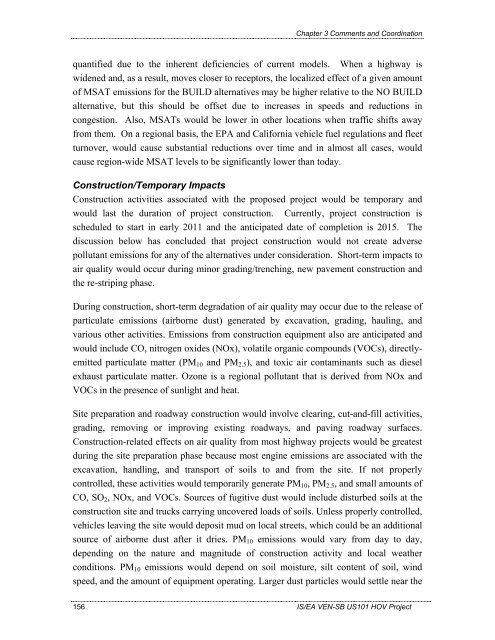Chapter 1 - Caltrans - State of California
Chapter 1 - Caltrans - State of California
Chapter 1 - Caltrans - State of California
You also want an ePaper? Increase the reach of your titles
YUMPU automatically turns print PDFs into web optimized ePapers that Google loves.
<strong>Chapter</strong> 3 Comments and Coordination<br />
quantified due to the inherent deficiencies <strong>of</strong> current models. When a highway is<br />
widened and, as a result, moves closer to receptors, the localized effect <strong>of</strong> a given amount<br />
<strong>of</strong> MSAT emissions for the BUILD alternatives may be higher relative to the NO BUILD<br />
alternative, but this should be <strong>of</strong>fset due to increases in speeds and reductions in<br />
congestion. Also, MSATs would be lower in other locations when traffic shifts away<br />
from them. On a regional basis, the EPA and <strong>California</strong> vehicle fuel regulations and fleet<br />
turnover, would cause substantial reductions over time and in almost all cases, would<br />
cause region-wide MSAT levels to be significantly lower than today.<br />
Construction/Temporary Impacts<br />
Construction activities associated with the proposed project would be temporary and<br />
would last the duration <strong>of</strong> project construction. Currently, project construction is<br />
scheduled to start in early 2011 and the anticipated date <strong>of</strong> completion is 2015. The<br />
discussion below has concluded that project construction would not create adverse<br />
pollutant emissions for any <strong>of</strong> the alternatives under consideration. Short-term impacts to<br />
air quality would occur during minor grading/trenching, new pavement construction and<br />
the re-striping phase.<br />
During construction, short-term degradation <strong>of</strong> air quality may occur due to the release <strong>of</strong><br />
particulate emissions (airborne dust) generated by excavation, grading, hauling, and<br />
various other activities. Emissions from construction equipment also are anticipated and<br />
would include CO, nitrogen oxides (NOx), volatile organic compounds (VOCs), directlyemitted<br />
particulate matter (PM10 and PM2.5), and toxic air contaminants such as diesel<br />
exhaust particulate matter. Ozone is a regional pollutant that is derived from NOx and<br />
VOCs in the presence <strong>of</strong> sunlight and heat.<br />
Site preparation and roadway construction would involve clearing, cut-and-fill activities,<br />
grading, removing or improving existing roadways, and paving roadway surfaces.<br />
Construction-related effects on air quality from most highway projects would be greatest<br />
during the site preparation phase because most engine emissions are associated with the<br />
excavation, handling, and transport <strong>of</strong> soils to and from the site. If not properly<br />
controlled, these activities would temporarily generate PM10, PM2.5, and small amounts <strong>of</strong><br />
CO, SO2, NOx, and VOCs. Sources <strong>of</strong> fugitive dust would include disturbed soils at the<br />
construction site and trucks carrying uncovered loads <strong>of</strong> soils. Unless properly controlled,<br />
vehicles leaving the site would deposit mud on local streets, which could be an additional<br />
source <strong>of</strong> airborne dust after it dries. PM10 emissions would vary from day to day,<br />
depending on the nature and magnitude <strong>of</strong> construction activity and local weather<br />
conditions. PM10 emissions would depend on soil moisture, silt content <strong>of</strong> soil, wind<br />
speed, and the amount <strong>of</strong> equipment operating. Larger dust particles would settle near the<br />
156 IS/EA VEN-SB US101 HOV Project

















